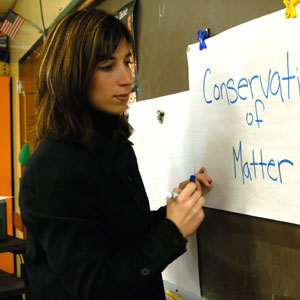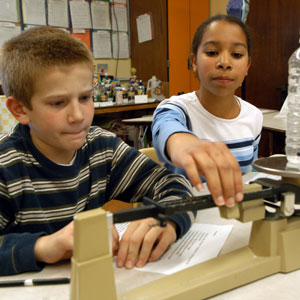Join us for conversations that inspire, recognize, and encourage innovation and best practices in the education profession.
Available on Apple Podcasts, Spotify, Google Podcasts, and more.
 “My interest in science started with my love of the outdoors and when I began wondering why things work the way they do. I feel that also from my students. Every time we do science experiments, they keep asking why, you know, and they want to know why is the sky blue, for example. I feel like teaching is a learning experience for everyone involved, including the teacher. I want my students to realize that I’m still learning, too, that it doesn’t stop here. And for them, that’s how it will be, and that this is just a stepping stone to the next adventure that is coming for them.”
“My interest in science started with my love of the outdoors and when I began wondering why things work the way they do. I feel that also from my students. Every time we do science experiments, they keep asking why, you know, and they want to know why is the sky blue, for example. I feel like teaching is a learning experience for everyone involved, including the teacher. I want my students to realize that I’m still learning, too, that it doesn’t stop here. And for them, that’s how it will be, and that this is just a stepping stone to the next adventure that is coming for them.”
Rebecca has been teaching for seven years — the last four at the Portsmouth Middle School. She is currently enrolled in a master’s in science education program at the University of Rhode Island, and also participates in a summer program in the engineering department at Brown University called “Research Experience for Teachers,” where she has developed modules that integrate math and science.
Portsmouth Middle School is divided into “learning centers,” each with about 70 students. Each learning center is in a square that’s divided by walls that can open and close. In Rebecca’s center, there are three classrooms and one open classroom. The students rotate from one class to the other and see different teachers throughout the day. According to Rebecca, “The whole concept behind it is that it gives the teachers an opportunity to work as a team… We can open up the walls and do something as a whole group, or we can close them up if we need to. Most of all, it allows us to give the students an environment where they feel safe to ask us questions, and where they feel comfortable.”
 Lesson at a Glance:
Lesson at a Glance:
Curriculum: EDC Insights, The Mysterious Powder, Kendall-Hunt Publishers
Grade: Upper elementary
Topic: Learning Experience 10: Using Science Skills to Describe a New Substance
Prior to this lesson, Rebecca’s class had been working for four weeks, investigating the different mystery powders, and trying to identify them by observing their properties during various chemical reactions.
In Rebecca’s adaptation of this lesson, the class took two substances that they were familiar with, baking soda and vinegar, and mixed them together. “They knew that there was going to be a chemical reaction,” says Rebecca, “but we took it a step further and put them into a closed container and weighed them before and after they were mixed, to see if the matter would be conserved.”
The first time the students did the experiment, they put a balloon over the top of the bottle in which the reaction occurred, so they could watch the newly created gas fill the balloon. When the class weighed their bottles afterwards, however, several students found that their bottles weighed less than they had before the reaction took place. Thinking that either the balloons had small holes in them or that the seals were leaky, Rebecca rethought the experiment and had the students replace the balloons with the bottle caps.
She recounts, “This time the students found that the substances weighed the same before and after they were combined, even though some of the matter disappeared from view. And I think it’s important that students realized that, sometimes in science when you do an experiment, it doesn’t always go the way you expect.”
After this lesson, Rebecca did several follow-up lessons where the students investigated conservation of matter through other chemical reactions. “It’s kind of a hard concept,” she said, “because if you watch a piece of wood burn, it seems to be gone. So, the idea is to get students to understand that it’s not gone; it’s just changed its form.”